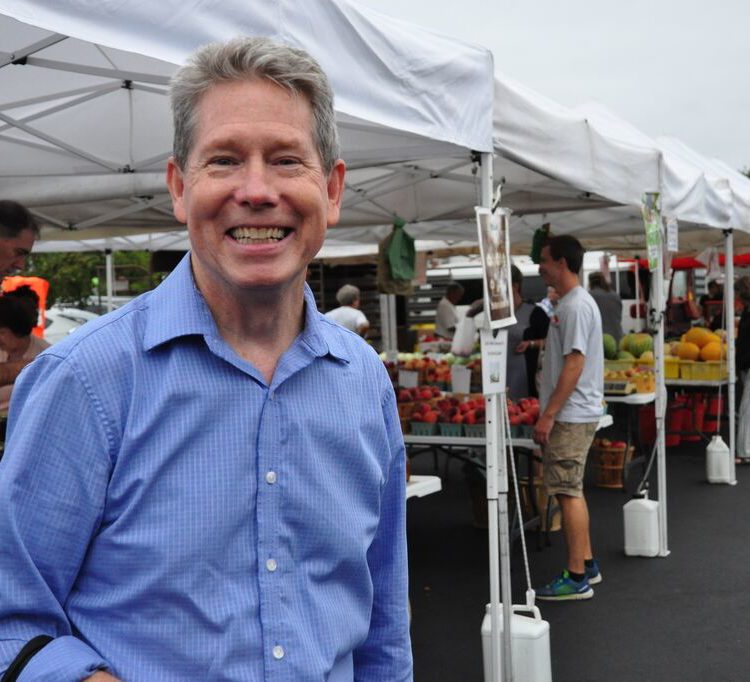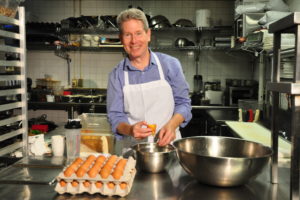A New Season and a New Start for the Chesapeake Kitchen

My apologies. I haven’t been posting in a while because it has been a busy few months for me! In addition to running Gertrude’s, I’ve been working with all the wonderful folks over at Johns Hopkins University Press on The 25th Anniversary Edition of Chesapeake Bay Cooking, which was released just last week.
Recently I was invited to bring some of the books, hot off the presses, over to the brand new Waverly Branch of the Pratt Libraries and give a little talk. So after my usual Saturday morning ritual of shopping and gabbing at the 32nd Street Farmers’ Market, I headed across the street to the library. Here’s a semi-faithful transcript of my talk that morning…
It was during the winter, early 70s, that I left my hometown of Baltimore, loaded my upright piano and hauled it north to Provincetown, on the outermost tip of Cape Cod, planning to become a “Rock Star,” a’la Elton John. Well, not much doing in the Rock Star World out on Cape Cod in the dead of wintertime I found out. But I did wind up filling in for a friend who broke his foot and couldn’t work his shifts at a large restaurant there. The first task the chef gave me was to peel up a bowl of fresh garlic. Well, here I was, an Irish Catholic boy from Baltimore —never even saw garlic before! I cut myself eight times… and so began my career in the culinary world.
About a decade later, that career took me out west to California and eventually I took a leap and decided to open my own place. Of course the question was, “What will I DO?” The obvious choice would have been a California nouvelle kinda thing, all the rage just then.
But one day it just came to me. I could see my grandmother Gertie—she would often bring me along to St. Ann’s Church in Waverly when they held their “Business Men’s Luncheons.” I remembered her and all the other volunteer church ladies working so hard. I loved helping out there, everyone laughing and joking around. We’d be shucking bushels of corn, stringing beans, and I loved the sense of camaraderie, the sense of community there. Suddenly I knew I had to do the kind of food that I loved, the food of my home.
So I opened a place out there and called it “Gertie’s Chesapeake Bay Café,” quite an anomaly for Berkeley, California in 1983, I’ll tell ya! But it was a huge hit. I had fresh stuff flown in almost everyday from Maryland. I had the blue crabs, the oysters—after a couple years of doing those airport runs my poor car smelled reallybad.
A couple years later, a regular customer who worked with Aris Books, a West Coast publishing house that at that time specifically published cookbooks, was keeping after me to do a book. He kept saying, “There are no cookbooks on Chesapeake cuisine. You should be the one to write one.” And finally, I took a leave of absence from the Café and I drove my little (smelly) Volkswagen bug across the country and for an entire year I traveled the Chesapeake, 200 miles north-to-south. What an inspiring and marvelous time it was. I met the most fascinating people from every imaginable walk of life. I worked hard to capture not only the flavor of the food but also importantly, the flavor of the people of the Chesapeake region, to bring the generous, charming, colorful, and often humorous personalities of the people who contributed to my book to life in its pages. A lot of folks have told me I succeeded, and I sure hope I did.
When Chesapeake Bay Cooking was published I was still living in Berkeley, California, although I was flying back and forth to Baltimore for what seemed like every other week—and it wasn’t long before that got real old. So I came back home, to stay—and the rest, as they say, is history, and Gertie’s Chesapeake Bay Café grew up to become Gertrude’s at the BMA.
Twenty five years ago, although it was gaining some ground out in California, here in the east the idea of “eating local/eating in season/shopping local” wasn’t really showing up on most folks radar, but honestly, for me, it was just the way we always ate at my house. At lot of my relatives were farmers. Many still are in Baltimore and Harford Counties. I kinda grew up in a world where I just thought that’s the way you eat. You grow it and you eat it.
My grandmother used to “put up” all kinds of things when they came into season. She even had a root cellar in her row home. So we did have wonderful food all winter, but the anticipation for some of the spring delicacies, such as rhubarb, asparagus, and strawberries would mount as spring approached. The season for most of these foods didn’t last a long time. We couldn’t have everything whenever we wanted, so we built up a real appreciation for things when we did have them.
This is the way folks always ate—with deep appreciation for foods at their best, fresh and in their season. I believe we’ve lost so much as global corporations and industrial agriculture have taken over. This hasn’t been an entirely good thing—for the environment, for our local economies, for our personal health or simply for our enjoyment of good food.
Things are changing. In fact, they have changed. When I opened Gertrude’s a professional chef couldn’t buy anything much that was local. The big suppliers just didn’t have it, didn’t quite know what you meant when you asked for it. I was very fortunate that the 32nd Street/Waverly Farmers Market was open all year round and was just a few blocks away. I was able to make such good, lasting friendships, face-to-face, with many local producers and food artisans right here in my own neighborhood.
I love good food. I love making good food that makes people happy. Being a chef can be a taxing business, but it’s exciting. In the kitchen you’re nervous and you’re rushing and then all the people come in and everyone is smiling. That’s what food does. It brings us all together around our common table in joyful community. And, you know, at this point in life, I can look back and see that being a chef and cookbook author has been a lot more fun than being a rock star could ever have been. I’ll probably live longer too!
On that note, with a thought to the season, here’s a simple recipe from the 25thAnniversary edition of Chesapeake Bay Cooking with John Shields for all those apples we have in such abundance this time of the year. Good old fashioned “puttin’ up,” as Gertie would say.
![]() Apple Butter
Apple Butter
It may come as some surprise that there is actually no butter in apple butter. The name refers to the smooth consistency of the finished product. A spicy spread made by slowly simmering apples with spices and apple cider, apple butter has been a staple in Chesapeake kitchens for generations. It is a perfect companion to breakfast rolls or warm, buttered toast.
Makes about 5 pint jars
5 pounds tart apples (about 16 medium apples), such as Granny Smith or Stayman
2 cups apple cider
2 cups sugar
2 teaspoons ground cinnamon
1 teaspoon ground cloves
1 teaspoon ground allspice
¼ cup apple cider vinegar
Cut the apples into quarters. It is not necessary to peel or core them. Place the apples in a heavy-bottomed pot. Pour in the apple cider and enough water to come about halfway up the apples. Cook until the apples are very soft. Press the mixture through a sieve or food mill and return to the pot.
Add the sugar, cinnamon, cloves, allspice, and vinegar. Cook over medium heat, stirring frequently, until thick and smooth, about 10 minutes.
Transfer to pint or half-pint containers and fill to 1/2 inch of the top. Immediately seal the lids and process for 10 minutes according to Hot-WaterBath Procedure.
Comments
Leave a Comment



Be the first to comment.